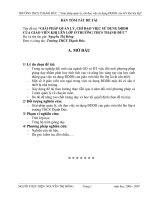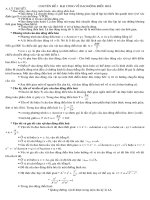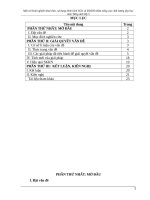DDDH SGK buổi 2
Bạn đang xem bản rút gọn của tài liệu. Xem và tải ngay bản đầy đủ của tài liệu tại đây (299.76 KB, 3 trang )
PRO 3M/3MPLUS – ƠN LUYỆN TỒN DIỆN CHO KÌ THI TỐT NGHIỆP THPT QUỐC GIA
Biên soạn: Cô Vũ Thị Mai Phương – Ngoaingu24h.vn
TÀI LIỆU ĐI KÈM LIVESTREAM
LUYỆN ĐỌC ĐIỀN - ĐỌC HIỂU – UNIT 2
Theo dõi LIVESTREAM ĐỘC QUYỀN của cơ vào lúc
20h30 ngày 19/9 duy nhất trên khóa học PRO 3MPLUS
Cô Vũ Thị Mai Phương
ai
:T
ge
Pa
Exercise 1. Read the following passage and mark the letter A, B, C or D to indicate the correct word or
phrase that best fits each of the numbered blanks.
Rapid urbanization can (1) ____ long-term economic, social and environmental promise for
developing countries (2) ____ investments made now in infrastructure, housing and public services are
efficient and sustainable, the World Bank says in a new report.
In the next two decades, cities are (3) ____ to expand by another two billion residents, as people move
in unprecedented (4) ____ from rural areas to pursue hopes and aspirations in cities. More than 90 (5)
____ of this urban population growth is expected to occur in the developing world, (6) ____ many cities
are already struggling to provide basic (7) ____ such as water, electricity, transport, health services and
education.
Report authors note that (8) ____ new urban growth will not take (9) ____ in the “megacities” of the
world e.g. Rio de Janeiro, Jakarta or New Delhi (10) ____ rather in less commonly recognized
“secondary” cities - places like Fushun in China, and Surat in India.
To help policymakers prepare for and manage growth, the report distills lessons (11) ____ from 12
countries across all geographic regions and stages of urbanization. It then translates these global lessons
(12) ____ practical policy advice.
Question 1. A. bring
B. carry
C. hold
D. take
Question 2. A. if
B. unless
C. whether
D. while
Question 3. A. predictable
B. predicted
C. predicting
D. predictions
Question 4. A. amounts
B. numbers
C. ranges
D. sums
Question 5. A. per cent
B. percentage
C. proportion
D. rate
Question 6. A. what
B. where
C. which
D. why
Question 7. A. demands
B. needs
C. orders
D. uses
Question 8. A. almost
B. most
C. mostly
D. nearly
Question 9. A. form
B. hand
C. place
D. time
Question 10. A. but
B. nor
C. or
D. yet
Question 11. A. are learned
B. being learned
C. learned
D. learning
Question 12. A. by
B. into
C. up to
D. up with
Exercise 2. Read the following passage and mark the letter A, B, C or D to indicate the correct answer
to each of the questions.
The increase in urbanization causes different problems. Air and water pollution are amongst the major
issue we have to tackle.
In the first place, cars, factories and burning waste emit dangerous gases that change the air quality in
our cities and pose threats to our health. Dangerous gases such as carbon dioxide and nitrogen oxides
cause respiratory diseases, for instant, bronchitis and asthma. Those are also proved to have long-term
effects on the environment.
eu
Li
K
a
ho
ay
H
oc
H
n
ie
M
im
iK
Ph
an
V
KHÓA HỌC PRO3M/PRO3MPLUS – CHINH PHỤC ĐIỂM 9+ MÔN TIẾNG ANH CÙNG CÔ VŨ MAI PHƯƠNG
PRO 3M/3MPLUS – ƠN LUYỆN TỒN DIỆN CHO KÌ THI TỐT NGHIỆP THPT QUỐC GIA
Biên soạn: Cô Vũ Thị Mai Phương – Ngoaingu24h.vn
ai
:T
ge
Pa
Furthermore, with the increased population, it becomes difficult to manage the waste generated in
cities. Most of the waste is discharged or dumped into rivers or onto streets. The waste pollutes water and
makes it unfit for human consumption. Subsequently, it becomes more and more difficult for city dwellers
to get clean water. Some cities in Africa are unable to provide adequate water supply because most of the
water is lost in pipe leakages. In fact, most city dwellers in developing countries are forced to boil their
water or to buy bottled water, which is very expensive.
There are several actions that could be taken to eradicate the problems described above. Firstly, a
simple solution would be joining community efforts to address problems affecting your city. Ask your
parents, friends and relatives to join in as well. These efforts might include clean-up campaigns, recycling
projects and a signature campaign to ask the government to do something about the situation. A second
measure would be encouraging your teacher to talk about these problems and to discuss how young people
can help to solve them. Finally, writing to local organizations working on these issues for ideas on how
you can contribute to solve them.
Question 13. The word tackle in paragraph 1 is closest in meaning to ____.
A. deal with
B. make up
C. try on
D. turn down
Question 14. The word those in paragraph 2 refers to ____.
A. bronchitis and asthma
B. carbon dioxide and nitrogen oxides
C. dangerous gases
D. respiratory diseases
Question 15. According to the passage, in some cities in Africa ____.
A. people are allowed to dump waste into rivers and on streets
B. people aren't provided enough water due to leaking pipes
C. people have found some solutions to the problems
D. people would rather use boiling water and bottled water
Question 16. Which of the following is NOT true according to the passage?
A. City problems should be taught and be topic for students to discuss at school.
B. Children must ask for their parent's permission before joining community efforts.
C. Participators might take part in different kinds of projects and campaigns.
D. People can contribute in solving the problems by writing to local organizations working on these issues.
Question 17. Which of the following would serve as the best title for the passage?
A. Environment degradation: Air and water pollution
B. Environmental pollution: Problems and actions
C. Increasing urbanization: Causes and effects
D. Increasing urbanization: Effects and solutions
Exercise 3. Read the following passage and mark the letter A, B, C or D to indicate the correct answer
to each of the questions.
Buying a house is the single largest financial investment an individual makes. Yet, in India this act is
fraught with risk and individuals depend on weak laws for justice. Occasionally, deviant promoters are
called to account as was the case in the detention of Unitech's promoters. This incident shows up the
fallout of an absence of proper regulation to cover contracts between buyers and real estate promoters. A
real estate bill, which is presently pending in Rajya Sabha, seeks to fill this gap. It has been debated for
over two years and should be passed by Parliament in the budget session.
India is in the midst of rapid urbanization and urban population is expected to more than double to
about 900 million over the next three decades. Unfortunately, even the current population does not have
adequate housing. A government estimate in 2012 put the shortage at nearly 19 million units. If this
shortage is to be alleviated quickly, India's messy real estate sector needs reforms.
eu
Li
K
a
ho
ay
H
oc
H
n
ie
M
im
iK
Ph
an
V
KHÓA HỌC PRO3M/PRO3MPLUS – CHINH PHỤC ĐIỂM 9+ MÔN TIẾNG ANH CÙNG CÔ VŨ MAI PHƯƠNG
PRO 3M/3MPLUS – ƠN LUYỆN TỒN DIỆN CHO KÌ THI TỐT NGHIỆP THPT QUỐC GIA
Biên soạn: Cô Vũ Thị Mai Phương – Ngoaingu24h.vn
ai
:T
ge
Pa
The real estate bill seeks to set standards for contracts between buyers and sellers. Transparency, a
rare commodity in real estate, is enforced as promoters have to upload project details on the regulators'
website. Importantly, standard definitions of terms mean that buyers will not feel cheated after taking
possession of a house. In order to protect buyers who pay upfront, a part of the money collected for a real
estate project is ring-fenced in a separate bank account. Also, given the uncertainty, which exists in India
on land titles, the real estate bill provides title insurance. This bill has been scrutinized by two
parliamentary committees and its passage now brooks no delay.
This bill is an important step in cleaning up the real estate market, but the journey should not end with
it. State governments play a significant role in real estate and they are often the source of problems. Some
estimates suggest that real estate developers have to seek approvals of as many as 40 central and state
departments, which lead to delays and an escalation in the cost of houses. Sensibly, NDA government's
project to provide universal urban housing forces states to institute reforms to access central funding.
Without real estate reforms at the level of states, it will not be possible to
meet the ambition of making housing accessible for all urban dwellers.
Question 18. It can be inferred from the passage that ____.
A. buying house is not a single largest individual investment
B. in India, no one depends on laws for justice
C. the real estate bill does not provide title insurance
D. urbanization in India has increased rapidly
Question 19. According to the passage, which of the following is the pending in Rajya Sabha?
A. NDA government's new scheme
B. Universal rural housing programme
C. Real estate bill
D. Universal urban housing programme
Question 20. Which of the following is NOT true according to the passage?
A. Current population does not have adequate housing in India.
B. India's real estate sector needs reforms.
C. Real state bill has been scrutinized by two parliamentary committees.
D. Urban population is expected to more than double to about 850 million over the next three decades.
Question 21. According to the passage, what is the source of problem in real estate?
A. Buyers and sellers
B. Central governments
C. Market money makers
D. State governments
Question 22. The word alleviated in the second paragraph is OPPOSITE in meaning to ____.
A. aggravated
B. deaden
C. diminished
D. relieved
Question 23. The word possession in the third paragraph refers to ____.
A. lease
B. need
C. proprietary rights
D. renting
Question 24. The word escalation in the forth paragraph refers to ____.
A. decrease
B. growth
C. reduction
D. sustainability
Question 25. It is impossible to meet the ambition of making housing accessible for urban dwellers ____.
A. with real estate reforms at state level
B. without support of central government
C. without passing the bill in Rajya Sabha
D. without real estate reforms at the level of states
eu
Li
K
a
ho
ay
H
oc
H
n
ie
M
im
iK
Ph
an
V
KHÓA HỌC PRO3M/PRO3MPLUS – CHINH PHỤC ĐIỂM 9+ MÔN TIẾNG ANH CÙNG CÔ VŨ MAI PHƯƠNG









